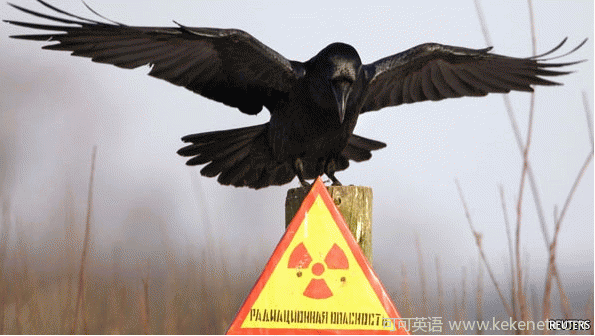
Science and Technolgy.
科技。
Radiation and evolution.
核輻射與進化。
Surviving fallout.
輻射塵中 幸免于難。
Birds can evolve to cope with the lingering effects of nuclear incidents.
鳥類能夠通過進化應對核事故的殘余影響。
THE disaster last year at the Fukushima Dai-ichi nuclear power plant, caused by an earthquake and tsunami, scored seven on the International Nuclear and Radiological Event Scale (INES). No worse rating exists. Radiation is harmful to living things, yet the long-term effects of persistently high levels of background radiation on ecosystems are poorly understood.With this in mind, a team led by Timothy Mousseau of the University of South Carolina and Anders Moller of the University of Paris-Sud set out to compare bird species dwelling near the Fukushima plant with those living at the site of another nuclear incident that scored a seven on the INES: the Ukrainian town of Chernobyl, where disaster struck in 1986. Remarkably, they found that some species seem to develop a tolerance for radioactivity over time.
去年,地震和海嘯引發了福島第一原子能發電站核泄漏事故,在國際核與輻射事件等級標準(INES)中被評為第七級;沒有比這情況還糟的分級了。核輻射對生物有害,而長時間高水平的本底輻射對生態系統有何影響,人們還知之甚少。為了研究這個問題,南卡羅萊納大學的Timothy Mousseau和巴黎第十一大學的Anders Moller率團隊著手比較在兩個INES七級事故事發地(福島核電站和1986年發生事故的烏克蘭小鎮切爾諾貝利)附近棲息的鳥類種群。結果出人意料。他們發現隨著時間遷移,似乎有些鳥類發展出了對核輻射的耐受力。
Fukushima and Chernobyl are more than 7,000km (4,350 miles) apart, but Dr Mousseau and his colleagues soon realised that the two sites had much in common. Both are in areas that have a temperate climate with species that have similar habits and needs. And both are surrounded by a mixture of farmland and forest. Upon closer examination the researchers found that 14 species of bird lived in both regions, including the barn swallow, great tit, great reed warbler, buzzard and Eurasian jay. With so many similarities between the two places, a comparison of the biological responses to radiation in each (recent in Fukushima; long-term in Chernobyl) would surely be illuminating.
福島和切爾諾貝利相距7,000余公里(4350英里),不過Mousseau和同事們很快發現,兩地的鳥類種群有共同之處。兩地均屬溫帶氣候,周圍環繞著農田和森林,鳥類的習性和需求相似。經過進一步調查,研究人員發現兩地有14種相同的鳥類,包括家燕、大山雀、大葦鶯、鵟、松鴉。既然情況如此相似,比較兩地生物對核輻射的反應(福島:短期反應,切爾諾貝利:長期反應)自然應當具有啟發意義。
To do this, during July 2011, the researchers counted and identified birds at 300 locations near Fukushima that had radiation levels as low as 0.5 microsieverts per hour and as high as 35 (for comparison, dental X-rays rarely expose patients to more than 0.05 microsieverts). Then they compared these results to bird data collected in areas that had the same range of radiation levels near Chernobyl between 2006 and 2009.
2011年7月,研究人員清點并鑒定了福島核電站附近300個地點的鳥類。這些地點的輻射水平低至0.5毫西弗/小時,高至35毫西弗/小時。作為對照,牙醫給患者拍X光片的輻射量很少超過0.05毫西弗。他們將結果與在切爾諾貝利周圍采集的數據進行了比對。這些數據采集于2006年~2009年間,采集地點的輻射水平與福島相似。
Their results, published in Environmental Pollution, show that as radiation levels in an area rose to 35 microsieverts per hour, the average number of birds dropped by almost a third compared with the areas where radiation levels were only 0.5 microsieverts per hour. This makes sense: in those areas with a high level of radiation, living things would tend to die or sicken and fail to reproduce. However, when researchers looked at the 14 bird species that lived in both regions, they found that the same level of radiation was associated with twice as large a drop in bird numbers in Fukushima as in Chernobyl.
研究結果發表在《環境污染》雜志上:在輻射水平為35毫西弗/小時的地方,鳥類平均數量比0.5毫西弗/小時的地方少了將近1/3。這是合情合理的:輻射水平高的地方,生物更容易生病死亡,更難繁衍后代。但是,當研究者比對兩地共有的14種鳥類時,發現在同樣的輻射水平下,福島的鳥類下降數量幾乎達到了切爾諾貝利的兩倍。
The reasons for this are not clear. It is possible that the composition of the radionuclides are proving more dangerous to the Fukushima birds than they are to the birds near Chernobyl. But Dr Mousseau suggests a more likely explanation is that evolution has already been at work near Chernobyl, killing off individual birds that cannot cope with the background radiation and allowing the genes of those that have some tolerance to be passed on. The birds at Fukushima are only beginning to face the evolutionary challenge of living in a radioactive world.
人們還不清楚這個現象的原因。也許是因為福島的放射性核素成分對鳥類更危險。不過Mousseau博士稱,這更可能是因為進化已經在切爾諾貝利周圍的鳥群中起作用了。不能適應本底輻射的鳥類死亡,對輻射有耐受力的基因則得以傳承。而福島的鳥類才剛剛開始面對輻射環境中的生存進化挑戰。











